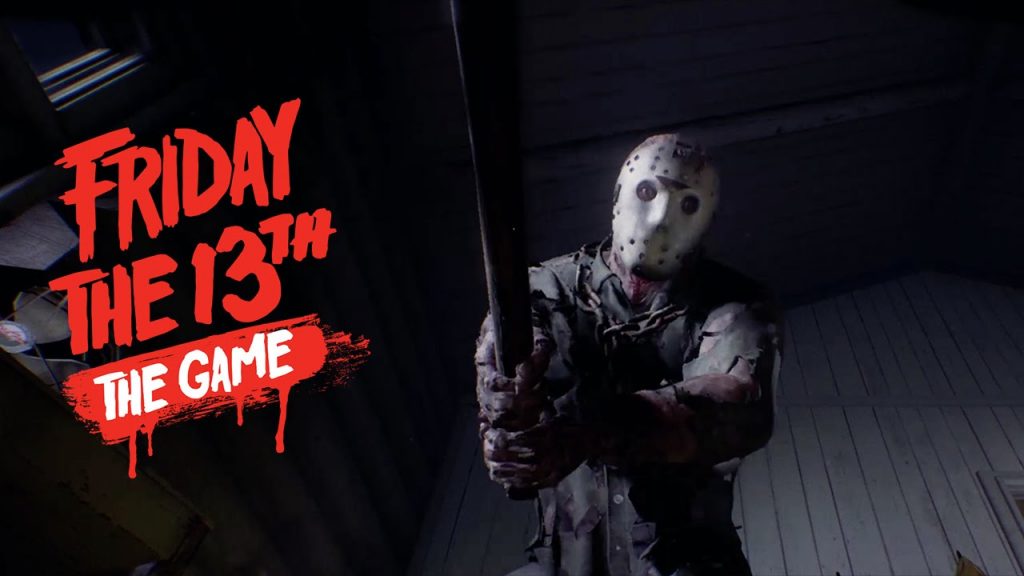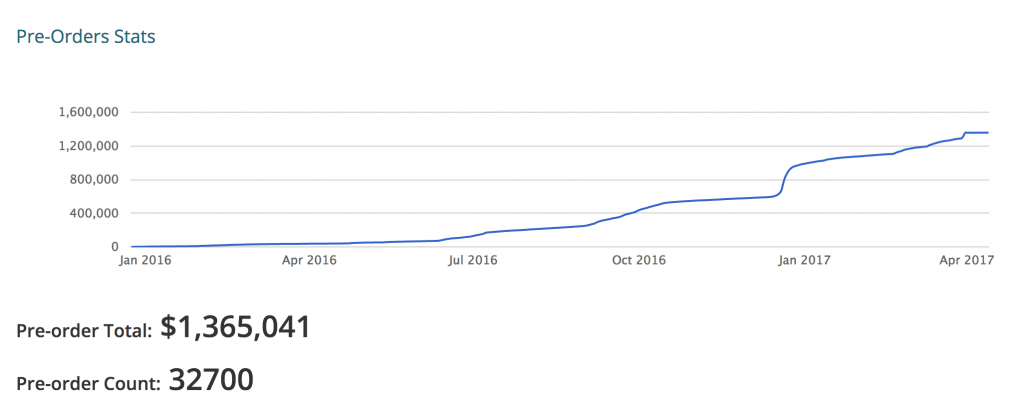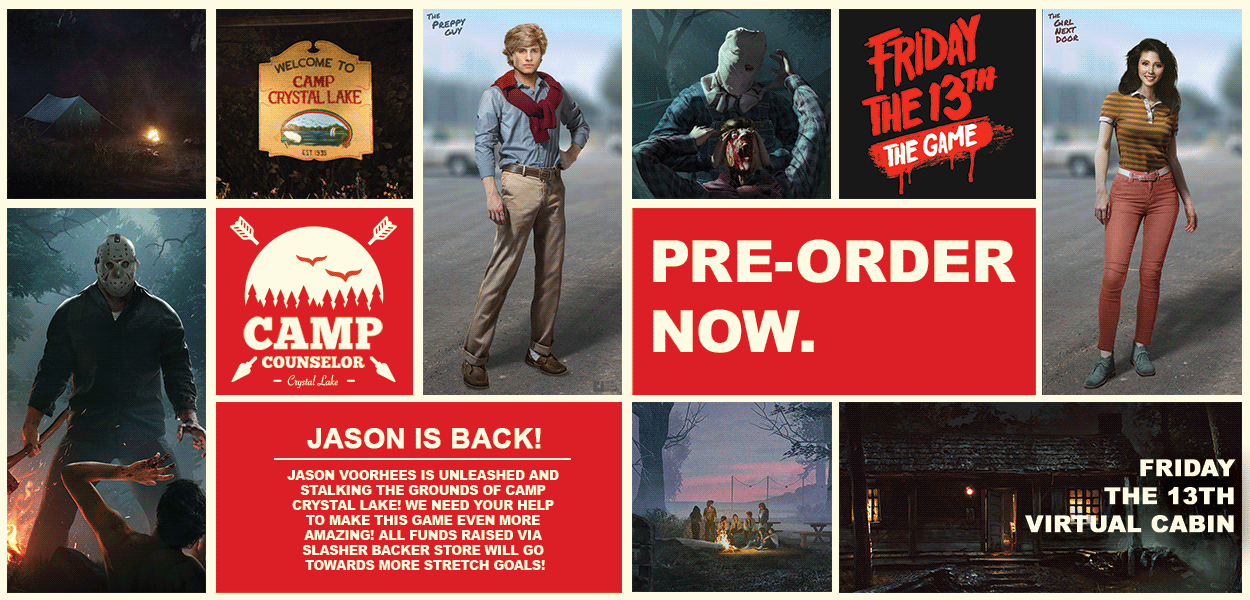When a crowdfunding campaign draws to a close, project creators typically witness a sudden influx of last-gasp backers rushing to back the project before it ends. Fresh attention is great news for any campaign, and a final surge of support can help to carry a project over the funding finishing line. But what can project creators do about those who missed out?
Enter pre-orders. Offering pre-orders can propel your campaign’s momentum outside of Kickstarter and Indiegogo, giving backers the opportunity to contribute to your campaign after it has ended. They’re an easy way to raise additional funds, which can sometimes end up covering platform fees or unexpected surprises in the fulfillment phase. Either way, the business case is compelling.
Sometimes, project creators raise more in pre-order sales than their original campaign. The creators of Friday the 13th, a multiplayer video game, raised $823,704 from 12,218 backers on Kickstarter, exceeding their funding goal by about $100,000.

Once the campaign ended, they offered pre-orders for digital and physical copies of the Friday the 13th game, art books, soundtracks, digital rewards, and other branded merchandise through BackerKit Pre-orders.
Friday the 13th made more money in pre-order sales than in its crowdfunding campaign, amassing $1.365 million from pre-order sales in BackerKit alone.
Alternatively, project creators can use pre-orders as a way to improve and iron out the flaws in their initial campaign. In fact, that’s what Jym Daniels did. Once his Kickstarter campaign for the Think Ink Pen met its funding goal, he used Indiegogo and Shopify to give his fidget-focus toy a second life.
“We launched our Kickstarter campaign on November 1, which is a terrible time of year – just before Christmas,” Daniels says. “You would never, ever want to launch any crowdfunding campaign before the holidays.” He intended to launch months earlier, but the marketing company he enlisted wanted to hold off the campaign until additional video content had been created.
The campaign met its funding goal, but Daniels had expected to raise more for the project. “We were pretty disappointed,” he says, but not discouraged.
“We knew it was still going to take us three months to produce the product, so why not continue to take preorders?”
Setting Up Shop
There are many ways to run a pre-order store. You can set one up independently, use a platform like Indiegogo or Shopify, or host a store through the BackerKit app. Pre-order stores hosted by BackerKit allow you to manage your campaign backers and pre-orders in the one place, and you can use a widget that places a store on your own website.
Setting up a pre-order store requires some planning. Don’t leave it ‘til the last minute! Regardless of the e-commerce platform selected, project creators should plan ahead to set up their store and test links to ensure backers don’t drop off once their crowdfunding campaign ends.
Once you’ve set up shop, it’s time to promote it. Don’t let your project recede from backers’ memories: make sure your followers and contact lists know that it is taking orders. If you’ve run a Kickstarter campaign beforehand, consider using Spotlight, which allows project creators to link to external websites, including your pre-order store. If you’ve set up a pre-order store in BackerKit, the app generates a link for project creators to share on social media and Spotlight. The app also prompts backers to share the link to your pre-order store with their followers on social media once they’ve completed your survey.
Some project creators worry that offering pre-orders after the campaign’s official end-date might frustrate their most loyal supporters. We’ve found such fears are unfounded. It’s now very common for crowdfunding campaigns to move into pre-orders.
Project creators can create some differentiation between pre-order backers and original backers by offering slightly different pricing for pre-order rewards, or shipping those pre-order rewards only after the original backer rewards have shipped. This approach allows you to give your most fervent backers preferential treatment while keeping your project open to the crowdfunding community.
Strategies to Drive Pre-order Sales
On December 14, 2016, Friday the 13th announced the release of two betas in a project update: there would be one for ‘Friends and Family’ (early supporters) and a ‘Pre-Order Closed Beta’ (for backers who pre-ordered the game on Kickstarter or BackerKit). Anyone who pre-ordered the game through BackerKit received five beta codes as well, which could be passed on to friends – a neat way to fuel excitement (and sales) through word of mouth. The project update also included a link to the BackerKit pre-order store.
To drum up more buzz, Friday the 13th announced it would stream the Pre-Order Closed Beta on Twitch. These marketing strategies helped fuel a large spike in preorders, which provided vital upward momentum and helped push the project from the $600,000 plateau to over 1.3 million in BackerKit pre-order sales.
The creators posted monthly project updates until the close of the pre-order store in April. These included the introduction of new character concepts, additional Twitch streams, and appearances at PAX South.
Meanwhile, Daniels and his team decided to take pre-orders for the Think Ink Pen on Indiegogo InDemand. He says the platform’s standing in the pre-order market and its exposure to news sites made it a no-brainer. He took the opportunity to supplement his marquee product, the Think Ink Pen, with related products such as ‘fidget sliders’, desk toys, and bundled deals in the InDemand campaign.
“We had a marketing company that devised for us an official launch, social media and news strategy, but they were finished up in December.” So, Daniels and his team devised a marketing strategy of their own to drive in pre-orders. They sent emails to a database of around 5,000 people, posted updates on social media channels, and secured a placement in Indiegogo’s promotional newsletter.
As it turns out, his bet paid off: the project raised about $150,000 in Indiegogo, compared to $67,000 on Kickstarter. “Initially, we would have been lucky to break even with our Kickstarter campaign. We did not fully expect our efforts on Indiegogo to double what we made on Kickstarter.”
They did, however, have a secret weapon: their product video. Daniels promoted the video through Facebook ads and paid for it to appear on Gadget Flow. From there, it was picked up by Viral Thread, which re-edited it and released it, and the rest is history: it was shared by social news sites like Unilad, which boast nearly 30 million Facebook followers, and 30-odd marketing sites on the web.
“Content is truly king,” Daniels says. “Media mentions help, but nothing compares to the experience of being picked up by a social influencer or large social media site. We immediately got contacted by people everywhere, who make their own version of the video.” He says project creators should keep this in mind. “If I were developing a product today, one of my big factors to consider is: what kind of content can I build around it?”
Daniels believes video content is worth the investment, particularly if the product has demonstrable and aesthetic appeal. “We’re investing most of our ad dollars in creating good video content around our product and delivering it to the companies that have picked it up in the past,” he says. He’s also looking at building more affiliate relationships with companies that post videos on their sites in exchange for a small fee. “It’s not a bad deal to acquire a customer and only pay 10 per cent, versus 50 per cent on a wholesale retail spread.”
